An Analysis of Research Methodologies in Social Sciences
VerifiedAdded on 2023/01/03
|8
|2575
|24
Essay
AI Summary
This essay provides a comprehensive overview of social science research, contrasting quantitative and qualitative methodologies. It begins with an introduction to social science research, emphasizing its purposes and the two primary research types. Part 1 delves into theoretical approaches, including positivism and interpretivism, highlighting their respective methodologies and applications. Section 2 outlines various quantitative research methods, such as survey research, correlational research, and experimental research. The essay then explores qualitative methods, including one-to-one interviews, focus groups, and case studies. The discussion extends to the importance of sample size in both quantitative and qualitative research. Part 2 analyzes the key arguments of both quantitative and qualitative articles, focusing on data collection methods like direct observation, surveys, and focus groups. The essay concludes by summarizing the significance of research in organizations and reiterating the use of quantitative and qualitative methods for drawing appropriate conclusions. The importance of data collection methods such as interviews and surveys is also highlighted.
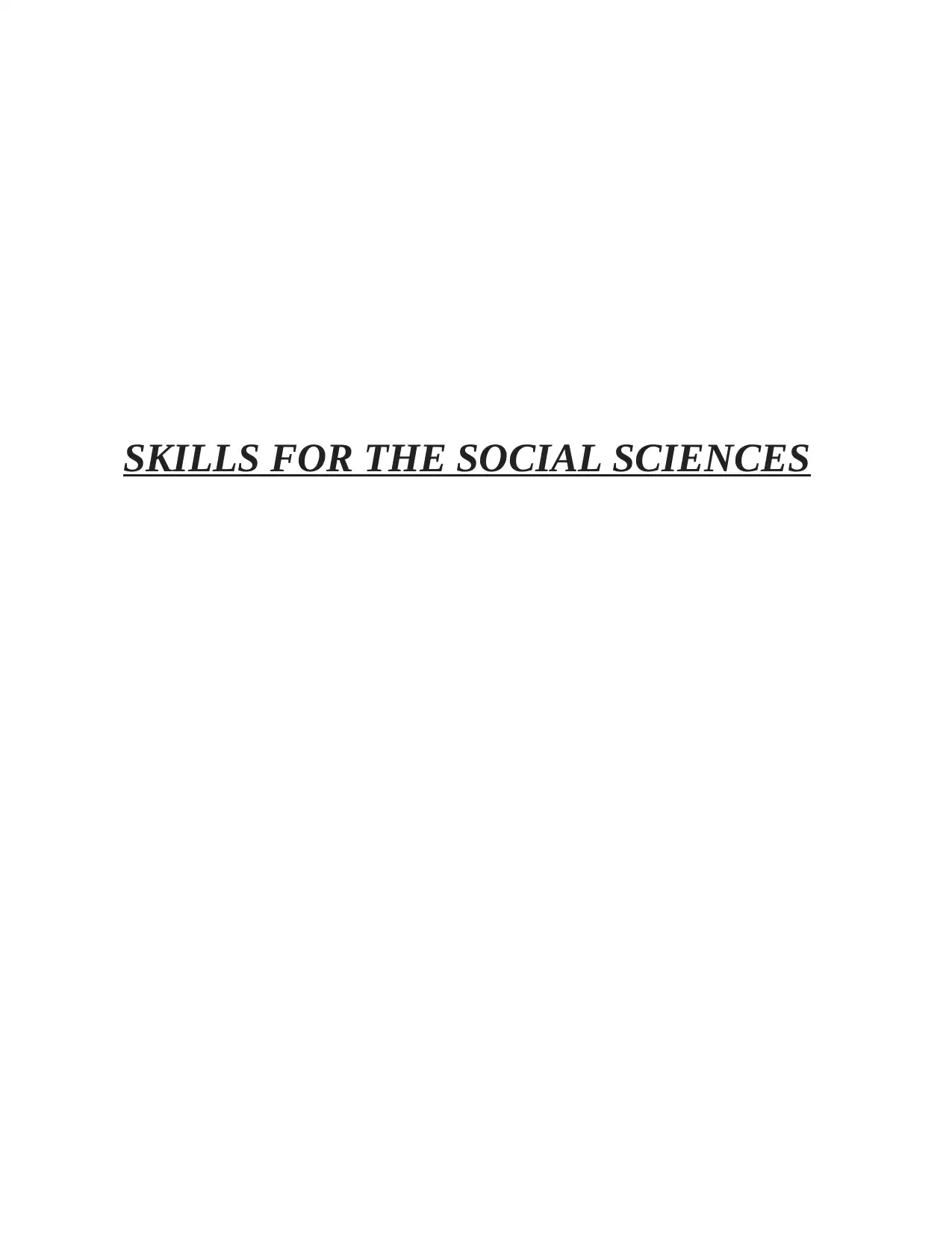
SKILLS FOR THE SOCIAL SCIENCES
Paraphrase This Document
Need a fresh take? Get an instant paraphrase of this document with our AI Paraphraser
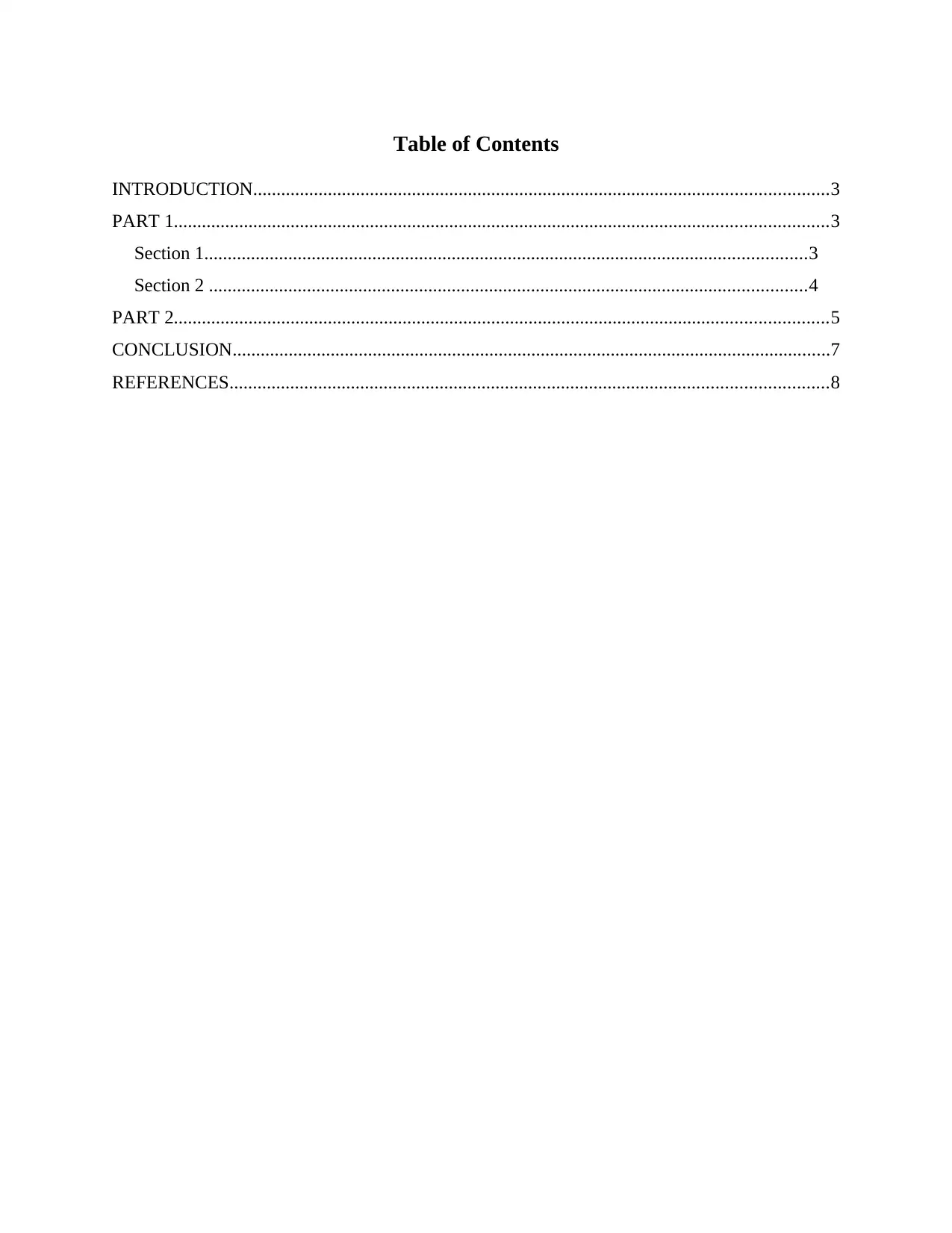
Table of Contents
INTRODUCTION...........................................................................................................................3
PART 1............................................................................................................................................3
Section 1.................................................................................................................................3
Section 2 ................................................................................................................................4
PART 2............................................................................................................................................5
CONCLUSION................................................................................................................................7
REFERENCES................................................................................................................................8
INTRODUCTION...........................................................................................................................3
PART 1............................................................................................................................................3
Section 1.................................................................................................................................3
Section 2 ................................................................................................................................4
PART 2............................................................................................................................................5
CONCLUSION................................................................................................................................7
REFERENCES................................................................................................................................8
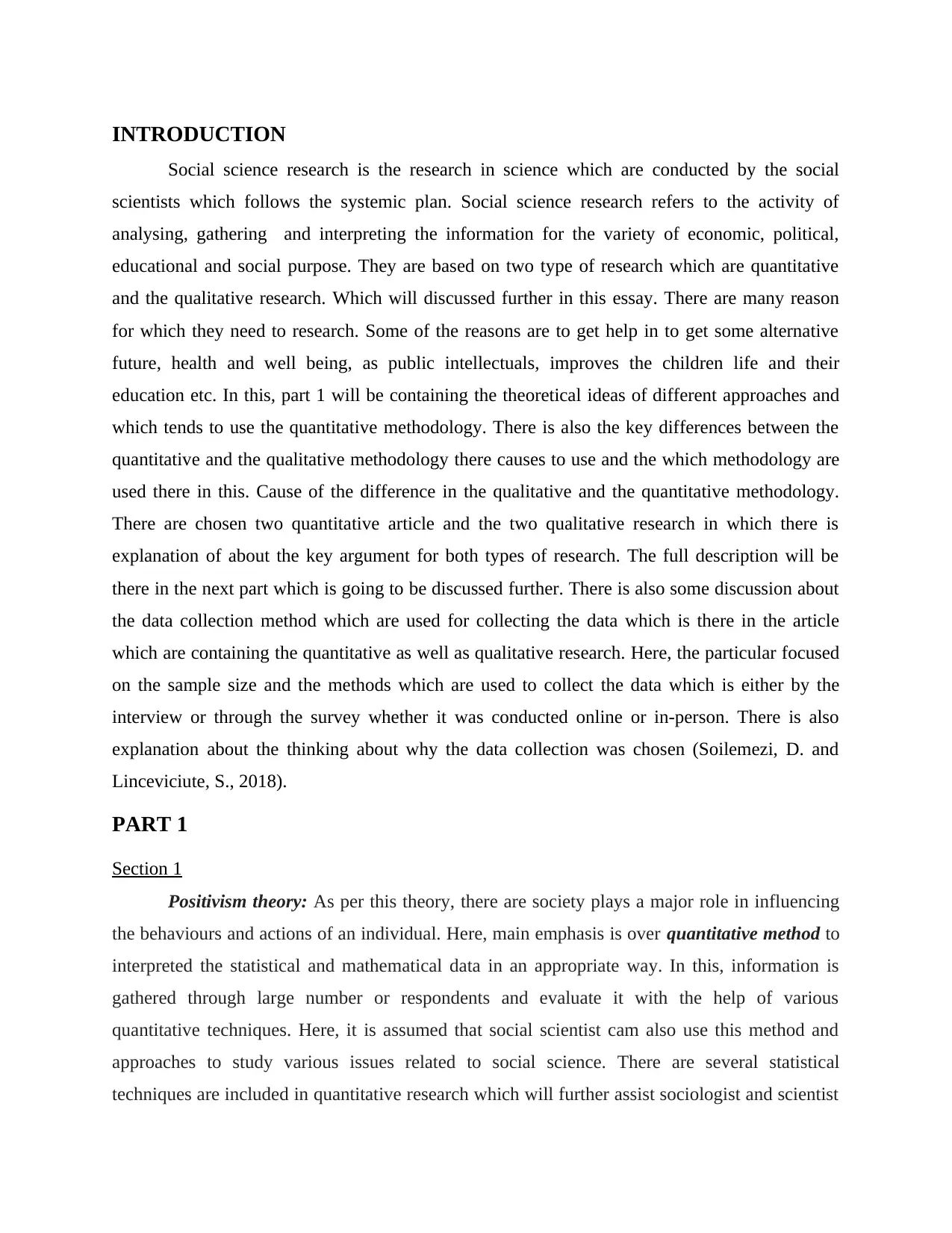
INTRODUCTION
Social science research is the research in science which are conducted by the social
scientists which follows the systemic plan. Social science research refers to the activity of
analysing, gathering and interpreting the information for the variety of economic, political,
educational and social purpose. They are based on two type of research which are quantitative
and the qualitative research. Which will discussed further in this essay. There are many reason
for which they need to research. Some of the reasons are to get help in to get some alternative
future, health and well being, as public intellectuals, improves the children life and their
education etc. In this, part 1 will be containing the theoretical ideas of different approaches and
which tends to use the quantitative methodology. There is also the key differences between the
quantitative and the qualitative methodology there causes to use and the which methodology are
used there in this. Cause of the difference in the qualitative and the quantitative methodology.
There are chosen two quantitative article and the two qualitative research in which there is
explanation of about the key argument for both types of research. The full description will be
there in the next part which is going to be discussed further. There is also some discussion about
the data collection method which are used for collecting the data which is there in the article
which are containing the quantitative as well as qualitative research. Here, the particular focused
on the sample size and the methods which are used to collect the data which is either by the
interview or through the survey whether it was conducted online or in-person. There is also
explanation about the thinking about why the data collection was chosen (Soilemezi, D. and
Linceviciute, S., 2018).
PART 1
Section 1
Positivism theory: As per this theory, there are society plays a major role in influencing
the behaviours and actions of an individual. Here, main emphasis is over quantitative method to
interpreted the statistical and mathematical data in an appropriate way. In this, information is
gathered through large number or respondents and evaluate it with the help of various
quantitative techniques. Here, it is assumed that social scientist cam also use this method and
approaches to study various issues related to social science. There are several statistical
techniques are included in quantitative research which will further assist sociologist and scientist
Social science research is the research in science which are conducted by the social
scientists which follows the systemic plan. Social science research refers to the activity of
analysing, gathering and interpreting the information for the variety of economic, political,
educational and social purpose. They are based on two type of research which are quantitative
and the qualitative research. Which will discussed further in this essay. There are many reason
for which they need to research. Some of the reasons are to get help in to get some alternative
future, health and well being, as public intellectuals, improves the children life and their
education etc. In this, part 1 will be containing the theoretical ideas of different approaches and
which tends to use the quantitative methodology. There is also the key differences between the
quantitative and the qualitative methodology there causes to use and the which methodology are
used there in this. Cause of the difference in the qualitative and the quantitative methodology.
There are chosen two quantitative article and the two qualitative research in which there is
explanation of about the key argument for both types of research. The full description will be
there in the next part which is going to be discussed further. There is also some discussion about
the data collection method which are used for collecting the data which is there in the article
which are containing the quantitative as well as qualitative research. Here, the particular focused
on the sample size and the methods which are used to collect the data which is either by the
interview or through the survey whether it was conducted online or in-person. There is also
explanation about the thinking about why the data collection was chosen (Soilemezi, D. and
Linceviciute, S., 2018).
PART 1
Section 1
Positivism theory: As per this theory, there are society plays a major role in influencing
the behaviours and actions of an individual. Here, main emphasis is over quantitative method to
interpreted the statistical and mathematical data in an appropriate way. In this, information is
gathered through large number or respondents and evaluate it with the help of various
quantitative techniques. Here, it is assumed that social scientist cam also use this method and
approaches to study various issues related to social science. There are several statistical
techniques are included in quantitative research which will further assist sociologist and scientist
⊘ This is a preview!⊘
Do you want full access?
Subscribe today to unlock all pages.

Trusted by 1+ million students worldwide
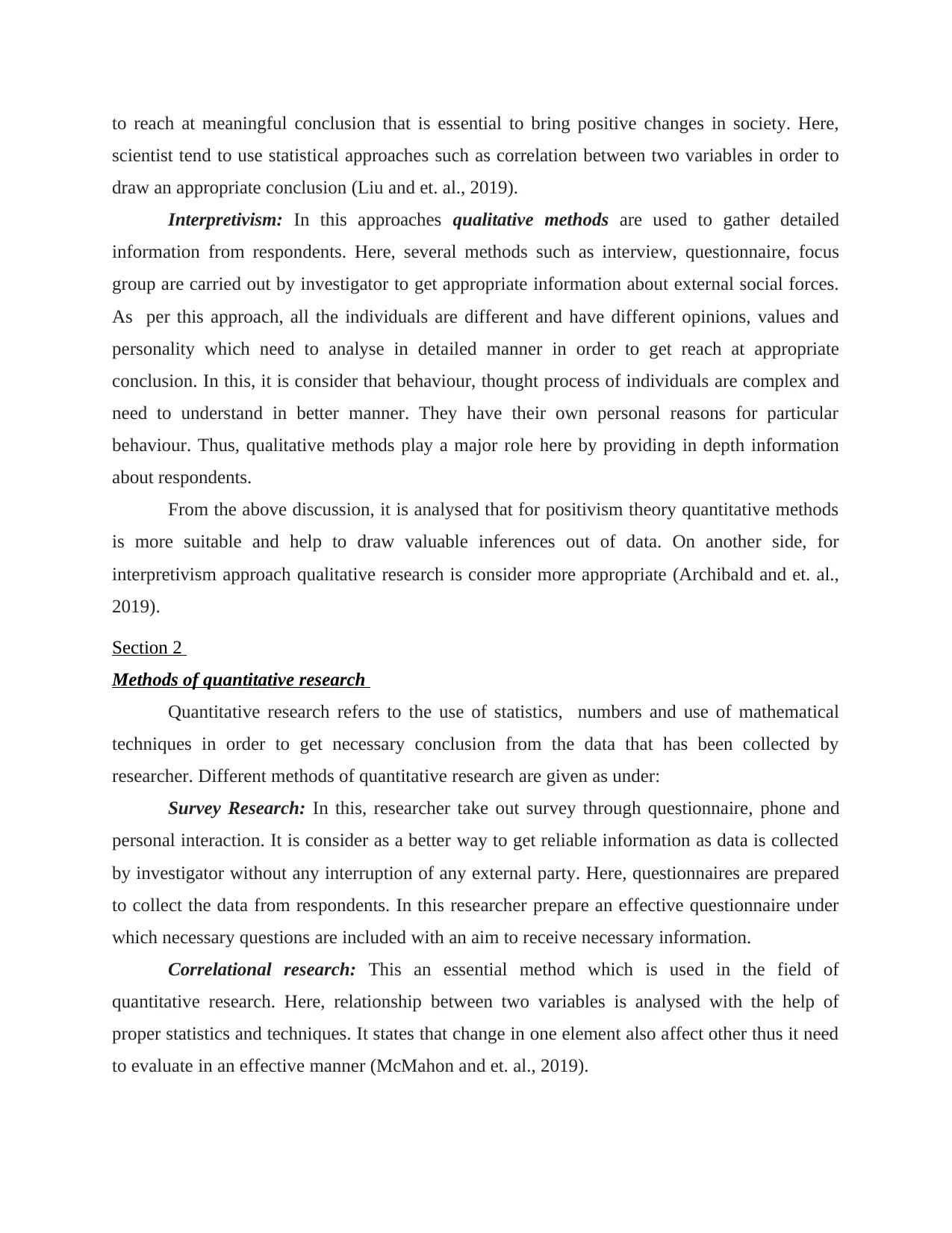
to reach at meaningful conclusion that is essential to bring positive changes in society. Here,
scientist tend to use statistical approaches such as correlation between two variables in order to
draw an appropriate conclusion (Liu and et. al., 2019).
Interpretivism: In this approaches qualitative methods are used to gather detailed
information from respondents. Here, several methods such as interview, questionnaire, focus
group are carried out by investigator to get appropriate information about external social forces.
As per this approach, all the individuals are different and have different opinions, values and
personality which need to analyse in detailed manner in order to get reach at appropriate
conclusion. In this, it is consider that behaviour, thought process of individuals are complex and
need to understand in better manner. They have their own personal reasons for particular
behaviour. Thus, qualitative methods play a major role here by providing in depth information
about respondents.
From the above discussion, it is analysed that for positivism theory quantitative methods
is more suitable and help to draw valuable inferences out of data. On another side, for
interpretivism approach qualitative research is consider more appropriate (Archibald and et. al.,
2019).
Section 2
Methods of quantitative research
Quantitative research refers to the use of statistics, numbers and use of mathematical
techniques in order to get necessary conclusion from the data that has been collected by
researcher. Different methods of quantitative research are given as under:
Survey Research: In this, researcher take out survey through questionnaire, phone and
personal interaction. It is consider as a better way to get reliable information as data is collected
by investigator without any interruption of any external party. Here, questionnaires are prepared
to collect the data from respondents. In this researcher prepare an effective questionnaire under
which necessary questions are included with an aim to receive necessary information.
Correlational research: This an essential method which is used in the field of
quantitative research. Here, relationship between two variables is analysed with the help of
proper statistics and techniques. It states that change in one element also affect other thus it need
to evaluate in an effective manner (McMahon and et. al., 2019).
scientist tend to use statistical approaches such as correlation between two variables in order to
draw an appropriate conclusion (Liu and et. al., 2019).
Interpretivism: In this approaches qualitative methods are used to gather detailed
information from respondents. Here, several methods such as interview, questionnaire, focus
group are carried out by investigator to get appropriate information about external social forces.
As per this approach, all the individuals are different and have different opinions, values and
personality which need to analyse in detailed manner in order to get reach at appropriate
conclusion. In this, it is consider that behaviour, thought process of individuals are complex and
need to understand in better manner. They have their own personal reasons for particular
behaviour. Thus, qualitative methods play a major role here by providing in depth information
about respondents.
From the above discussion, it is analysed that for positivism theory quantitative methods
is more suitable and help to draw valuable inferences out of data. On another side, for
interpretivism approach qualitative research is consider more appropriate (Archibald and et. al.,
2019).
Section 2
Methods of quantitative research
Quantitative research refers to the use of statistics, numbers and use of mathematical
techniques in order to get necessary conclusion from the data that has been collected by
researcher. Different methods of quantitative research are given as under:
Survey Research: In this, researcher take out survey through questionnaire, phone and
personal interaction. It is consider as a better way to get reliable information as data is collected
by investigator without any interruption of any external party. Here, questionnaires are prepared
to collect the data from respondents. In this researcher prepare an effective questionnaire under
which necessary questions are included with an aim to receive necessary information.
Correlational research: This an essential method which is used in the field of
quantitative research. Here, relationship between two variables is analysed with the help of
proper statistics and techniques. It states that change in one element also affect other thus it need
to evaluate in an effective manner (McMahon and et. al., 2019).
Paraphrase This Document
Need a fresh take? Get an instant paraphrase of this document with our AI Paraphraser
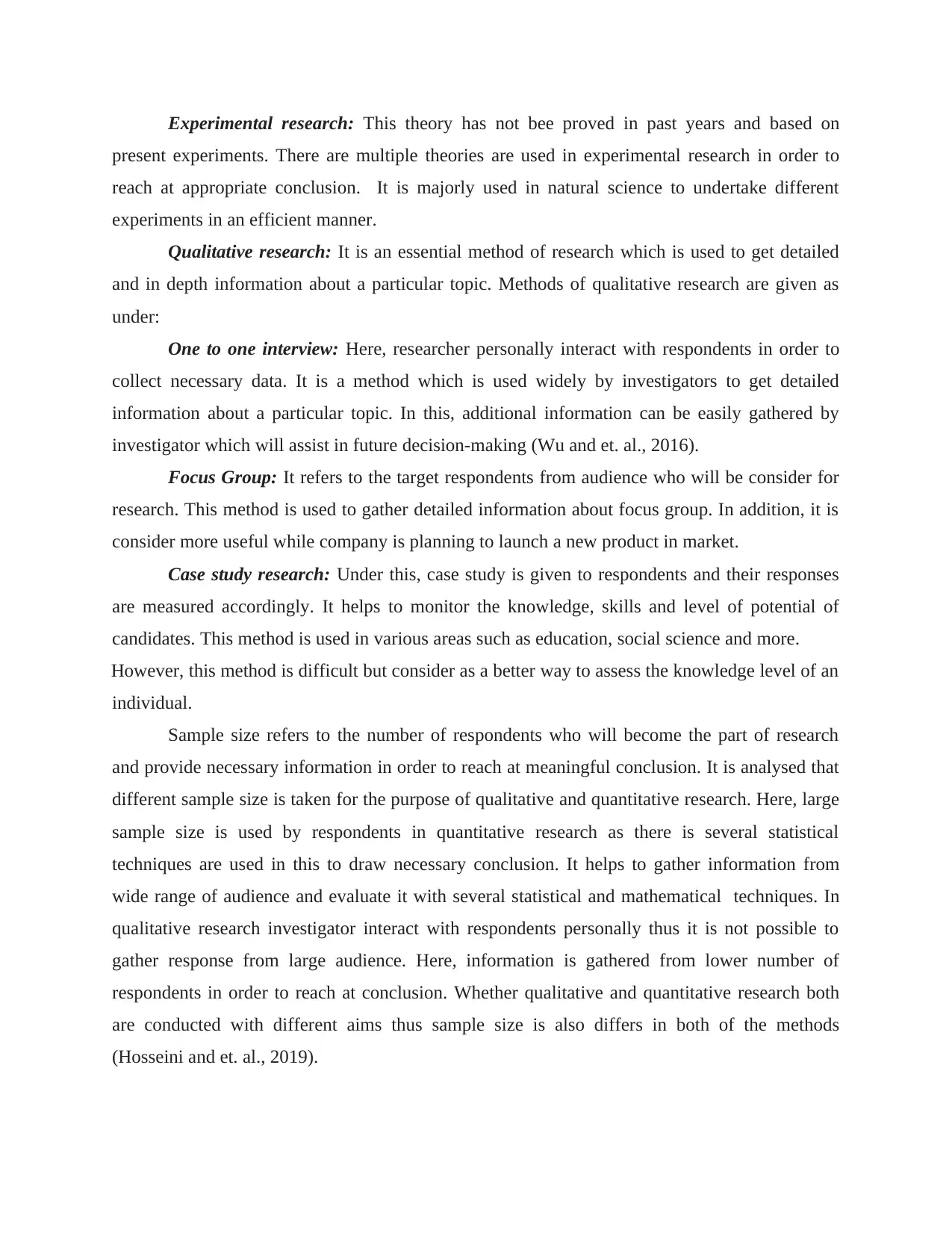
Experimental research: This theory has not bee proved in past years and based on
present experiments. There are multiple theories are used in experimental research in order to
reach at appropriate conclusion. It is majorly used in natural science to undertake different
experiments in an efficient manner.
Qualitative research: It is an essential method of research which is used to get detailed
and in depth information about a particular topic. Methods of qualitative research are given as
under:
One to one interview: Here, researcher personally interact with respondents in order to
collect necessary data. It is a method which is used widely by investigators to get detailed
information about a particular topic. In this, additional information can be easily gathered by
investigator which will assist in future decision-making (Wu and et. al., 2016).
Focus Group: It refers to the target respondents from audience who will be consider for
research. This method is used to gather detailed information about focus group. In addition, it is
consider more useful while company is planning to launch a new product in market.
Case study research: Under this, case study is given to respondents and their responses
are measured accordingly. It helps to monitor the knowledge, skills and level of potential of
candidates. This method is used in various areas such as education, social science and more.
However, this method is difficult but consider as a better way to assess the knowledge level of an
individual.
Sample size refers to the number of respondents who will become the part of research
and provide necessary information in order to reach at meaningful conclusion. It is analysed that
different sample size is taken for the purpose of qualitative and quantitative research. Here, large
sample size is used by respondents in quantitative research as there is several statistical
techniques are used in this to draw necessary conclusion. It helps to gather information from
wide range of audience and evaluate it with several statistical and mathematical techniques. In
qualitative research investigator interact with respondents personally thus it is not possible to
gather response from large audience. Here, information is gathered from lower number of
respondents in order to reach at conclusion. Whether qualitative and quantitative research both
are conducted with different aims thus sample size is also differs in both of the methods
(Hosseini and et. al., 2019).
present experiments. There are multiple theories are used in experimental research in order to
reach at appropriate conclusion. It is majorly used in natural science to undertake different
experiments in an efficient manner.
Qualitative research: It is an essential method of research which is used to get detailed
and in depth information about a particular topic. Methods of qualitative research are given as
under:
One to one interview: Here, researcher personally interact with respondents in order to
collect necessary data. It is a method which is used widely by investigators to get detailed
information about a particular topic. In this, additional information can be easily gathered by
investigator which will assist in future decision-making (Wu and et. al., 2016).
Focus Group: It refers to the target respondents from audience who will be consider for
research. This method is used to gather detailed information about focus group. In addition, it is
consider more useful while company is planning to launch a new product in market.
Case study research: Under this, case study is given to respondents and their responses
are measured accordingly. It helps to monitor the knowledge, skills and level of potential of
candidates. This method is used in various areas such as education, social science and more.
However, this method is difficult but consider as a better way to assess the knowledge level of an
individual.
Sample size refers to the number of respondents who will become the part of research
and provide necessary information in order to reach at meaningful conclusion. It is analysed that
different sample size is taken for the purpose of qualitative and quantitative research. Here, large
sample size is used by respondents in quantitative research as there is several statistical
techniques are used in this to draw necessary conclusion. It helps to gather information from
wide range of audience and evaluate it with several statistical and mathematical techniques. In
qualitative research investigator interact with respondents personally thus it is not possible to
gather response from large audience. Here, information is gathered from lower number of
respondents in order to reach at conclusion. Whether qualitative and quantitative research both
are conducted with different aims thus sample size is also differs in both of the methods
(Hosseini and et. al., 2019).
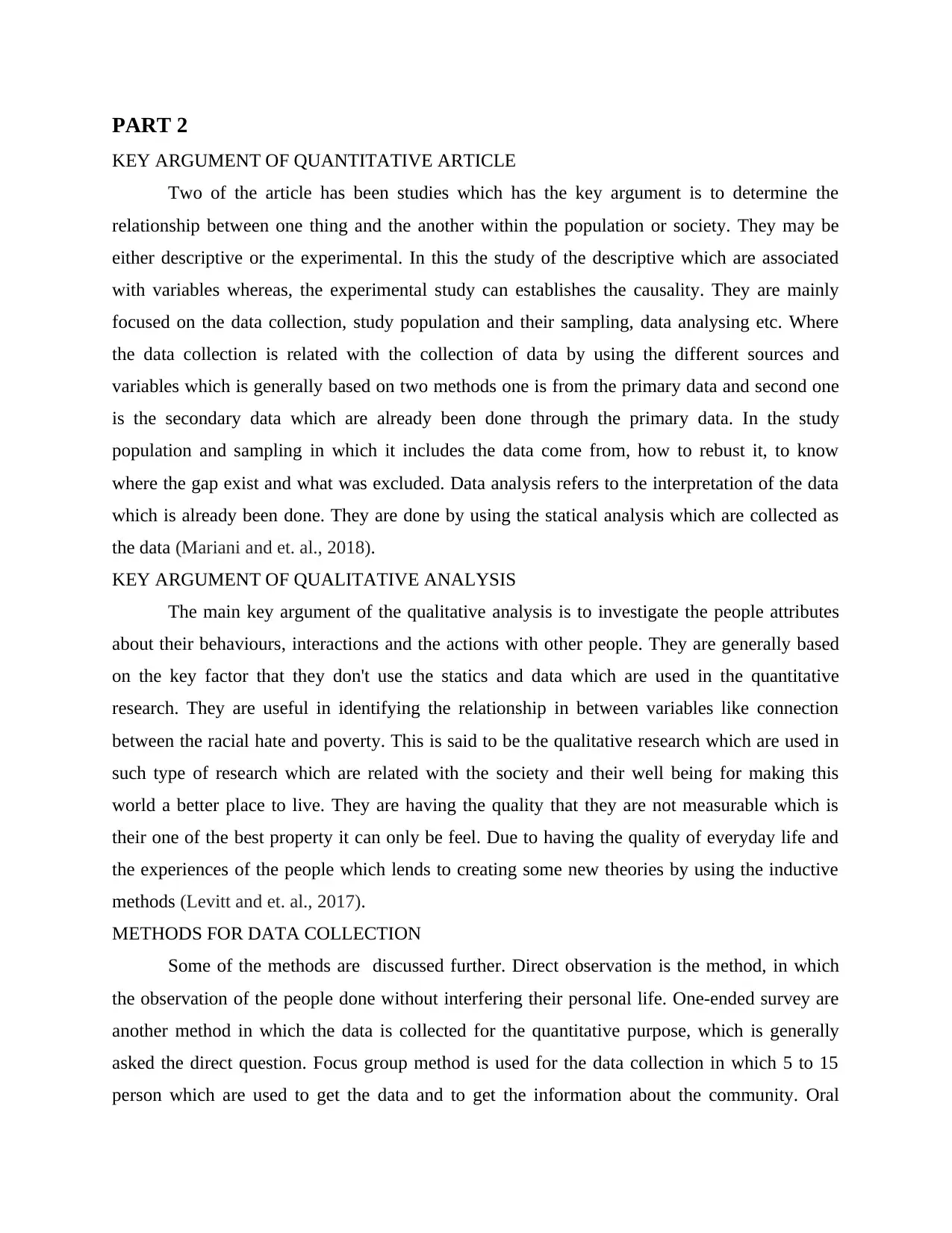
PART 2
KEY ARGUMENT OF QUANTITATIVE ARTICLE
Two of the article has been studies which has the key argument is to determine the
relationship between one thing and the another within the population or society. They may be
either descriptive or the experimental. In this the study of the descriptive which are associated
with variables whereas, the experimental study can establishes the causality. They are mainly
focused on the data collection, study population and their sampling, data analysing etc. Where
the data collection is related with the collection of data by using the different sources and
variables which is generally based on two methods one is from the primary data and second one
is the secondary data which are already been done through the primary data. In the study
population and sampling in which it includes the data come from, how to rebust it, to know
where the gap exist and what was excluded. Data analysis refers to the interpretation of the data
which is already been done. They are done by using the statical analysis which are collected as
the data (Mariani and et. al., 2018).
KEY ARGUMENT OF QUALITATIVE ANALYSIS
The main key argument of the qualitative analysis is to investigate the people attributes
about their behaviours, interactions and the actions with other people. They are generally based
on the key factor that they don't use the statics and data which are used in the quantitative
research. They are useful in identifying the relationship in between variables like connection
between the racial hate and poverty. This is said to be the qualitative research which are used in
such type of research which are related with the society and their well being for making this
world a better place to live. They are having the quality that they are not measurable which is
their one of the best property it can only be feel. Due to having the quality of everyday life and
the experiences of the people which lends to creating some new theories by using the inductive
methods (Levitt and et. al., 2017).
METHODS FOR DATA COLLECTION
Some of the methods are discussed further. Direct observation is the method, in which
the observation of the people done without interfering their personal life. One-ended survey are
another method in which the data is collected for the quantitative purpose, which is generally
asked the direct question. Focus group method is used for the data collection in which 5 to 15
person which are used to get the data and to get the information about the community. Oral
KEY ARGUMENT OF QUANTITATIVE ARTICLE
Two of the article has been studies which has the key argument is to determine the
relationship between one thing and the another within the population or society. They may be
either descriptive or the experimental. In this the study of the descriptive which are associated
with variables whereas, the experimental study can establishes the causality. They are mainly
focused on the data collection, study population and their sampling, data analysing etc. Where
the data collection is related with the collection of data by using the different sources and
variables which is generally based on two methods one is from the primary data and second one
is the secondary data which are already been done through the primary data. In the study
population and sampling in which it includes the data come from, how to rebust it, to know
where the gap exist and what was excluded. Data analysis refers to the interpretation of the data
which is already been done. They are done by using the statical analysis which are collected as
the data (Mariani and et. al., 2018).
KEY ARGUMENT OF QUALITATIVE ANALYSIS
The main key argument of the qualitative analysis is to investigate the people attributes
about their behaviours, interactions and the actions with other people. They are generally based
on the key factor that they don't use the statics and data which are used in the quantitative
research. They are useful in identifying the relationship in between variables like connection
between the racial hate and poverty. This is said to be the qualitative research which are used in
such type of research which are related with the society and their well being for making this
world a better place to live. They are having the quality that they are not measurable which is
their one of the best property it can only be feel. Due to having the quality of everyday life and
the experiences of the people which lends to creating some new theories by using the inductive
methods (Levitt and et. al., 2017).
METHODS FOR DATA COLLECTION
Some of the methods are discussed further. Direct observation is the method, in which
the observation of the people done without interfering their personal life. One-ended survey are
another method in which the data is collected for the quantitative purpose, which is generally
asked the direct question. Focus group method is used for the data collection in which 5 to 15
person which are used to get the data and to get the information about the community. Oral
⊘ This is a preview!⊘
Do you want full access?
Subscribe today to unlock all pages.

Trusted by 1+ million students worldwide
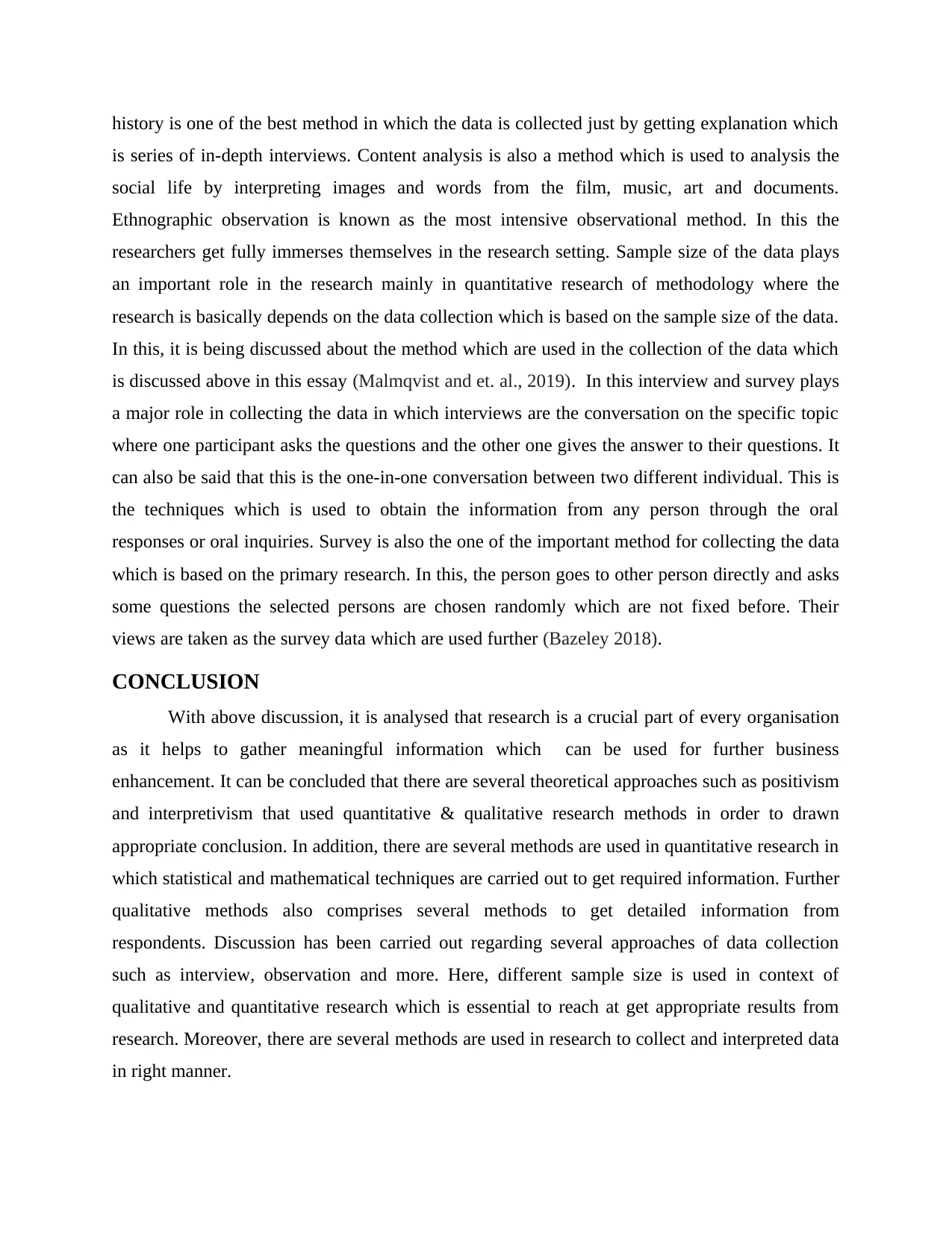
history is one of the best method in which the data is collected just by getting explanation which
is series of in-depth interviews. Content analysis is also a method which is used to analysis the
social life by interpreting images and words from the film, music, art and documents.
Ethnographic observation is known as the most intensive observational method. In this the
researchers get fully immerses themselves in the research setting. Sample size of the data plays
an important role in the research mainly in quantitative research of methodology where the
research is basically depends on the data collection which is based on the sample size of the data.
In this, it is being discussed about the method which are used in the collection of the data which
is discussed above in this essay (Malmqvist and et. al., 2019). In this interview and survey plays
a major role in collecting the data in which interviews are the conversation on the specific topic
where one participant asks the questions and the other one gives the answer to their questions. It
can also be said that this is the one-in-one conversation between two different individual. This is
the techniques which is used to obtain the information from any person through the oral
responses or oral inquiries. Survey is also the one of the important method for collecting the data
which is based on the primary research. In this, the person goes to other person directly and asks
some questions the selected persons are chosen randomly which are not fixed before. Their
views are taken as the survey data which are used further (Bazeley 2018).
CONCLUSION
With above discussion, it is analysed that research is a crucial part of every organisation
as it helps to gather meaningful information which can be used for further business
enhancement. It can be concluded that there are several theoretical approaches such as positivism
and interpretivism that used quantitative & qualitative research methods in order to drawn
appropriate conclusion. In addition, there are several methods are used in quantitative research in
which statistical and mathematical techniques are carried out to get required information. Further
qualitative methods also comprises several methods to get detailed information from
respondents. Discussion has been carried out regarding several approaches of data collection
such as interview, observation and more. Here, different sample size is used in context of
qualitative and quantitative research which is essential to reach at get appropriate results from
research. Moreover, there are several methods are used in research to collect and interpreted data
in right manner.
is series of in-depth interviews. Content analysis is also a method which is used to analysis the
social life by interpreting images and words from the film, music, art and documents.
Ethnographic observation is known as the most intensive observational method. In this the
researchers get fully immerses themselves in the research setting. Sample size of the data plays
an important role in the research mainly in quantitative research of methodology where the
research is basically depends on the data collection which is based on the sample size of the data.
In this, it is being discussed about the method which are used in the collection of the data which
is discussed above in this essay (Malmqvist and et. al., 2019). In this interview and survey plays
a major role in collecting the data in which interviews are the conversation on the specific topic
where one participant asks the questions and the other one gives the answer to their questions. It
can also be said that this is the one-in-one conversation between two different individual. This is
the techniques which is used to obtain the information from any person through the oral
responses or oral inquiries. Survey is also the one of the important method for collecting the data
which is based on the primary research. In this, the person goes to other person directly and asks
some questions the selected persons are chosen randomly which are not fixed before. Their
views are taken as the survey data which are used further (Bazeley 2018).
CONCLUSION
With above discussion, it is analysed that research is a crucial part of every organisation
as it helps to gather meaningful information which can be used for further business
enhancement. It can be concluded that there are several theoretical approaches such as positivism
and interpretivism that used quantitative & qualitative research methods in order to drawn
appropriate conclusion. In addition, there are several methods are used in quantitative research in
which statistical and mathematical techniques are carried out to get required information. Further
qualitative methods also comprises several methods to get detailed information from
respondents. Discussion has been carried out regarding several approaches of data collection
such as interview, observation and more. Here, different sample size is used in context of
qualitative and quantitative research which is essential to reach at get appropriate results from
research. Moreover, there are several methods are used in research to collect and interpreted data
in right manner.
Paraphrase This Document
Need a fresh take? Get an instant paraphrase of this document with our AI Paraphraser
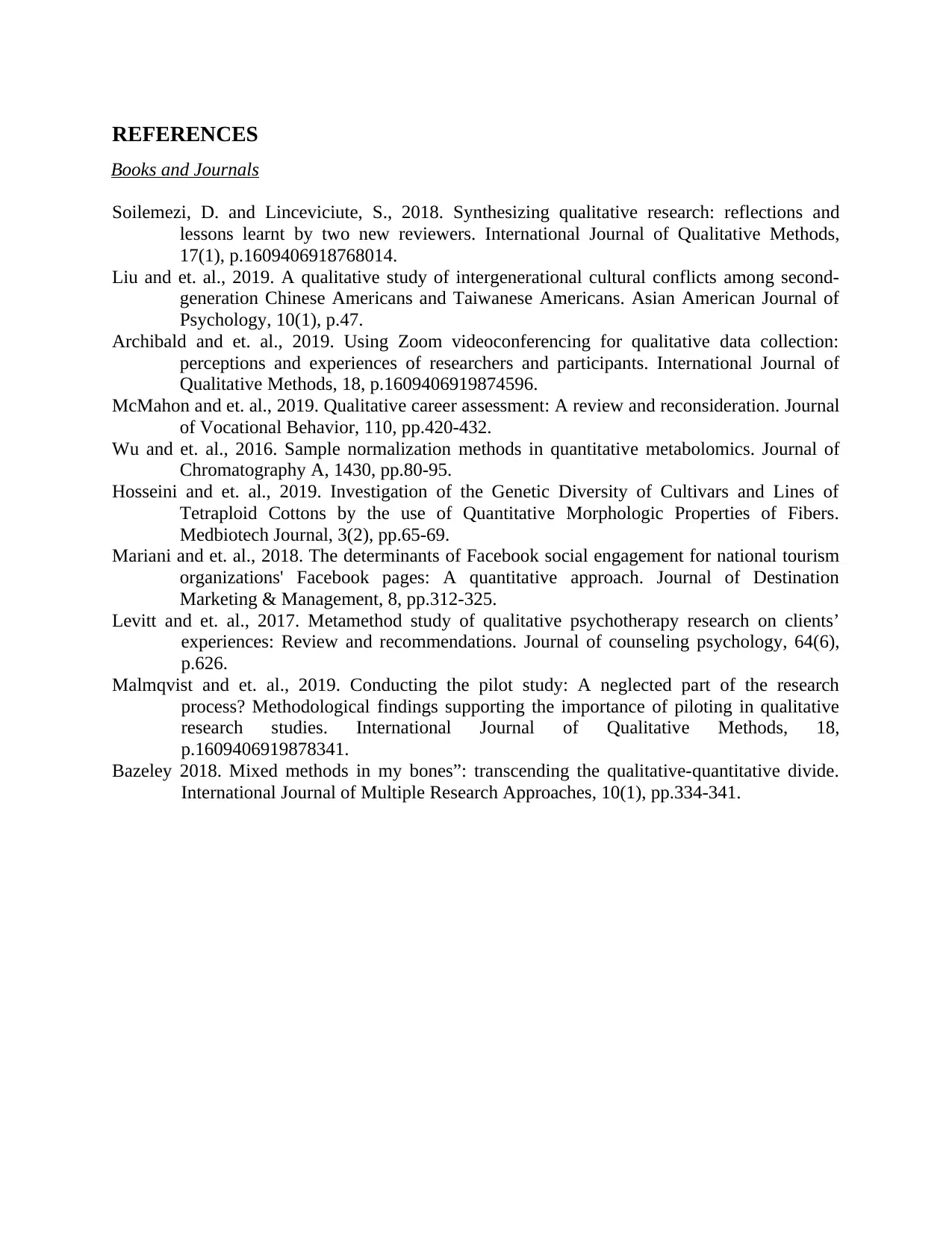
REFERENCES
Books and Journals
Soilemezi, D. and Linceviciute, S., 2018. Synthesizing qualitative research: reflections and
lessons learnt by two new reviewers. International Journal of Qualitative Methods,
17(1), p.1609406918768014.
Liu and et. al., 2019. A qualitative study of intergenerational cultural conflicts among second-
generation Chinese Americans and Taiwanese Americans. Asian American Journal of
Psychology, 10(1), p.47.
Archibald and et. al., 2019. Using Zoom videoconferencing for qualitative data collection:
perceptions and experiences of researchers and participants. International Journal of
Qualitative Methods, 18, p.1609406919874596.
McMahon and et. al., 2019. Qualitative career assessment: A review and reconsideration. Journal
of Vocational Behavior, 110, pp.420-432.
Wu and et. al., 2016. Sample normalization methods in quantitative metabolomics. Journal of
Chromatography A, 1430, pp.80-95.
Hosseini and et. al., 2019. Investigation of the Genetic Diversity of Cultivars and Lines of
Tetraploid Cottons by the use of Quantitative Morphologic Properties of Fibers.
Medbiotech Journal, 3(2), pp.65-69.
Mariani and et. al., 2018. The determinants of Facebook social engagement for national tourism
organizations' Facebook pages: A quantitative approach. Journal of Destination
Marketing & Management, 8, pp.312-325.
Levitt and et. al., 2017. Metamethod study of qualitative psychotherapy research on clients’
experiences: Review and recommendations. Journal of counseling psychology, 64(6),
p.626.
Malmqvist and et. al., 2019. Conducting the pilot study: A neglected part of the research
process? Methodological findings supporting the importance of piloting in qualitative
research studies. International Journal of Qualitative Methods, 18,
p.1609406919878341.
Bazeley 2018. Mixed methods in my bones”: transcending the qualitative-quantitative divide.
International Journal of Multiple Research Approaches, 10(1), pp.334-341.
Books and Journals
Soilemezi, D. and Linceviciute, S., 2018. Synthesizing qualitative research: reflections and
lessons learnt by two new reviewers. International Journal of Qualitative Methods,
17(1), p.1609406918768014.
Liu and et. al., 2019. A qualitative study of intergenerational cultural conflicts among second-
generation Chinese Americans and Taiwanese Americans. Asian American Journal of
Psychology, 10(1), p.47.
Archibald and et. al., 2019. Using Zoom videoconferencing for qualitative data collection:
perceptions and experiences of researchers and participants. International Journal of
Qualitative Methods, 18, p.1609406919874596.
McMahon and et. al., 2019. Qualitative career assessment: A review and reconsideration. Journal
of Vocational Behavior, 110, pp.420-432.
Wu and et. al., 2016. Sample normalization methods in quantitative metabolomics. Journal of
Chromatography A, 1430, pp.80-95.
Hosseini and et. al., 2019. Investigation of the Genetic Diversity of Cultivars and Lines of
Tetraploid Cottons by the use of Quantitative Morphologic Properties of Fibers.
Medbiotech Journal, 3(2), pp.65-69.
Mariani and et. al., 2018. The determinants of Facebook social engagement for national tourism
organizations' Facebook pages: A quantitative approach. Journal of Destination
Marketing & Management, 8, pp.312-325.
Levitt and et. al., 2017. Metamethod study of qualitative psychotherapy research on clients’
experiences: Review and recommendations. Journal of counseling psychology, 64(6),
p.626.
Malmqvist and et. al., 2019. Conducting the pilot study: A neglected part of the research
process? Methodological findings supporting the importance of piloting in qualitative
research studies. International Journal of Qualitative Methods, 18,
p.1609406919878341.
Bazeley 2018. Mixed methods in my bones”: transcending the qualitative-quantitative divide.
International Journal of Multiple Research Approaches, 10(1), pp.334-341.
1 out of 8
Related Documents
Your All-in-One AI-Powered Toolkit for Academic Success.
+13062052269
info@desklib.com
Available 24*7 on WhatsApp / Email
![[object Object]](/_next/static/media/star-bottom.7253800d.svg)
Unlock your academic potential
Copyright © 2020–2025 A2Z Services. All Rights Reserved. Developed and managed by ZUCOL.





